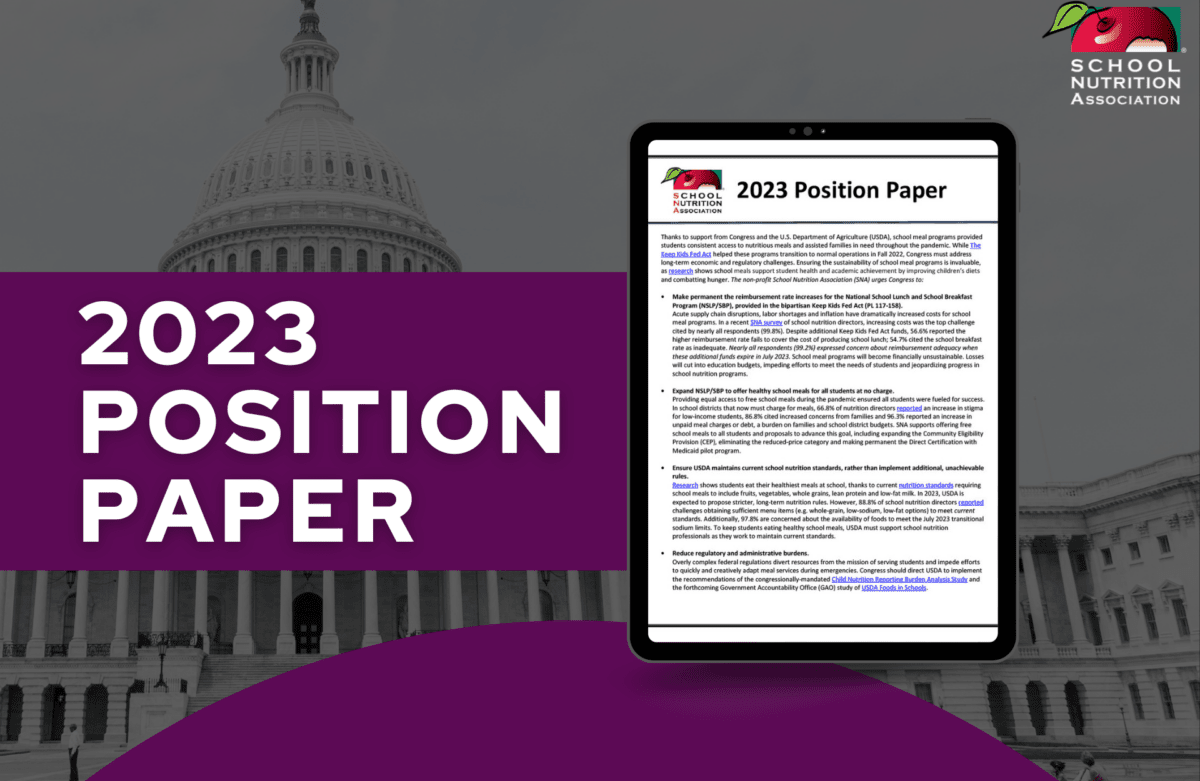Contact: Diane Pratt-Heavner, 703-576-7526, media@schoolnutrition.org
SNA Urges USDA to Maintain Current School Meal Rules
Proposed rule is unrealistic due to supply chain, labor challenges
ARLINGTON, VA – The nonprofit School Nutrition Association (SNA) is urging USDA to maintain current school nutrition standards rather than implement newly proposed rules that are unachievable for most schools nationwide. Last month, SNA released a survey report citing critical long-term economic and regulatory challenges facing school meal programs and published its 2023 Position Paper, which calls for maintaining current rules to keep students eating nutritious school meals.
“Research shows students receive their healthiest meals at school, thanks to current nutrition standards,” said SNA President Lori Adkins, MS, SNS, CHE. “As schools nationwide contend with persistent supply chain, labor and financial challenges, school meal programs are struggling to successfully maintain current standards and need support, not additional, unrealistic requirements.”
National labor shortages and supply chain disruptions had a lasting impact on the K-12 foodservice industry, limiting manufacturers’ and distributors’ capacity to produce and stock foods that meet highly specialized school nutrition standards, which limit calories, fat and sodium. In SNA’s 2023 School Nutrition Trends Survey of school meal program directors nationwide:
88.8% of respondents reported challenges obtaining sufficient menu items (e.g. whole-grain, low-sodium, low-fat options) to meet current standards.
Federal waivers that protect schools from financial penalty if they cannot meet nutrition standards due to supply chain issues will expire June 30, 2023. Then, despite struggling to maintain current Target 1 sodium reductions, schools must also meet previously established Target 1A transitional sodium limits (effective July 2023). According to the survey:
- 97.8% of school nutrition directors are concerned about the availability of foods that meet Target 1A sodium limits and are acceptable to students.
- More than 90% reported challenges with menu item shortages, discontinued menu items and supply shortages.
- Meanwhile, 92.9% are challenged by staff shortages, which can limit efforts to increase scratch cooking.
With no end in sight to supply chain and labor challenges, a majority of survey respondents also indicated concerns about proposals to establish long-term standards that exceed Target 1A transitional sodium limits (98.3%) and limit added sugar (94.4%). Proposed sugar limits initially target specific products, such as breakfast cereal. However, for respondents struggling with supply chain challenges, breakfast items (eg cereals, granola bars, biscuits, pancakes) were the most challenging foods to procure.
SNA will submit more detailed comments in response to the proposed rule and continue discussions with USDA officials on ways to support school meal programs and ensure student acceptance of healthy school meals.
“We see children choose not to eat at all if a meal is not familiar or appetizing to them, and it’s heartbreaking, particularly for food insecure families who rely on school meals,” said Adkins. ”School nutrition staff work tirelessly to keep students choosing and consuming healthy school meals; we must continue to support those efforts.”
In March, school nutrition professionals from across the country will meet with their Members of Congress to discuss these issues and SNA’s 2023 Position Paper, as part of the 51st annual Legislative Action Conference (LAC).
About School Nutrition Association:
The School Nutrition Association (SNA) is a national, non-profit professional organization representing 50,000 school nutrition professionals across the country. Founded in 1946, SNA and its members are dedicated to making healthy school meals and nutrition education available to all students. For more information on school meals, visit www.SchoolNutrition.org/SchoolMeals.
Related Articles

USDA Halts FY25 Patrick Leahy Farm to School Grants
Read More





